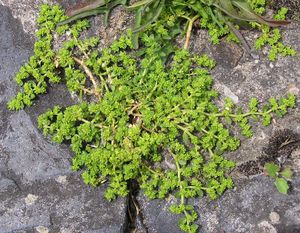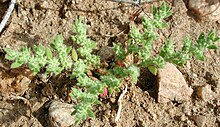Broken herbs
| Broken herbs | ||||||||||||
|---|---|---|---|---|---|---|---|---|---|---|---|---|

Bald hernia ( Herniaria glabra ) |
||||||||||||
| Systematics | ||||||||||||
|
||||||||||||
| Scientific name | ||||||||||||
| Herniaria | ||||||||||||
| L. |
The herniaria ( Herniaria ) are a genus within the family of the Pink family (Caryophyllaceae). The 30 to 45 species are distributed in Europe and from the Mediterranean region to West and Central Asia.
Origin of name
The common name of broken herb comes from its earlier use as a medicine for abdominal hernias. Because of their diuretic effect, they were also called urinary herbs .
description

Vegetative characteristics
Broken herb species are annual to perennial herbaceous plants . The strongly branched stems grow flat along the ground. The growth of the stem and the leaves is quite characteristic of most species: The actually opposite leaves are twisted so that they sit on the two flanks of the stem, so that an apparently two-line leaf position is created. Of the two opposite leaves, one on each side of the stem is greatly reduced. A side shoot forms in the axilla of this reduced leaf. Stipules are present.
Generative characteristics
The sessile flowers are clustered in clusters in the axils of the reduced leaves. The tiny, inconspicuous and greenish flowers are four or mostly five-fold with a double flower envelope . The usually five greenish or whitish sepals are 0.5 to 1.5 mm in size. Most of the five petals are tiny and often missing. There are (rarely two to) usually four to five fertile stamens and five staminodes . The two thread-like styluses are 0.1 to 0.4 mm long.
They form solitary nut fruits . The shiny, smooth seeds are dark brown or black.
Systematics and distribution
The genus Herniaria belongs to the tribe Paronychieae in the subfamily Paronychioideae within the family Caryophyllaceae and was previously classified in the family Illecebraceae.
The 30 to 45 break herb species ( Herniaria ) are naturally widespread in the Mediterranean and in the temperate areas of West and Central Asia and Europe as far as Scandinavia . Some species are neophytes in the temperate areas of the world.
Here only the species found in Europe or the Mediterranean area:


- Herniaria acrochaeta (Bornm.) Chaudhri : The homeland is Israel and Jordan.
- Herniaria algarvica Chaudhri : The home is Portugal.
- Alpine break herb ( Herniaria alpina Chaix ): It occurs only in the Alps and the Pyrenees .
- Herniaria arabica hand .-- Mazz. : The home is Lebanon and Syria.
- Herniaria argaea Boiss. : The home is Turkey.
- Herniaria baetica Boiss. & Reut. : The home is Spain.
- Herniaria boissieri J.Gay : Home is Spain and Morocco.
- Herniaria bornmuelleri Chaudhri : The home is Italy.
- Herniaria canariensis Chaudhri : The home is Tenerife.
- Herniaria caucasica Rupr. : It occurs in Southwest Asia , Kazakhstan , Russia , Mongolia and Xinjiang .
- Herniaria ciliolata Melderis : It occurs in Portugal, Spain, France and Great Britain.
- Herniaria cyrenaica F. Herm. : The homeland is Egypt and Libya.
- Herniaria degenii (F.Herm.) Chaudhri : The homeland is Greece and the Aegean Sea.
- Herniaria ericifolia F. Towns. : The home is Libya.
- Herniaria fontanesii J.Gay : It occurs in Spain, Sicily, the Canary Islands, Morocco, Algeria, Tunisia, Libya, Egypt and on the Sinai Peninsula.
- Herniaria fruticosa L .: The home is Spain.
- Bald hernia ( Herniaria glabra L. ): It occurs in Europe, Russia, Uzbekistan, Afghanistan, Mongolia, western Sichuan and northern Xinjiang.
- Herniaria hartungii Parl . : It occurs on Fuerteventura.
- Herniaria hemistemon J.Gay : It occurs in North Africa and the Middle East.
- Hairy broken herb ( Herniaria hirsuta L. )
- Gray broken herb ( Herniaria incana Lam. ): It occurs in southern and southeastern Europe.
- Herniaria latifolia Lapeyr. : The homeland is Spain, France, Corsica and Sardinia.
- Herniaria lenticulata Huds.
- Herniaria litardierei (Gamisans) Greuter & Burdet : The home is Corsica and Sardinia.
- Herniaria lusitanica Chaudhri : The home is Portugal and Spain.
- Herniaria maritima Link : The home is Portugal and Morocco.
- Herniaria mauritanica Murb. : The homeland is Algeria and Tunisia.
- Herniaria micrantha A.K. Jacks. & Turrill : The home is the Aegean Sea, Cyprus and Turkey.
- Herniaria nigrimontium F. Herm . : The homeland is Greece, Bulgaria and Macedonia.
- Herniaria olympica J.Gay : It occurs in Turkey and Bulgaria.
- Herniaria oranensis Chaudhri : The homeland is Algeria.
- Herniaria orientalis F. Herm. : The home is Turkey.
- Parnassic hernia Boiss. : The home is the Balkan Peninsula with Greece and Crete.
- Herniaria permixta cast. : The homeland is Morocco.
- Herniaria pisidica Brummitt : Home is Turkey.
- Herniaria polygama J.Gay : It occurs in Eastern Europe (only in Poland, Ukraine and Moldova), Russia and China (Xinjiang).
- Herniaria pujosii Sauvage & Vindt : The homeland is Morocco and Algeria.
- Herniaria regnieri Braun-Blanq. & Maire : The home is Spain, Algeria and Morocco.
- Herniaria rhiphaea Font Quer : The homeland is Morocco.
- Herniaria saxatilis Brummitt : The home is Turkey.
- Herniaria scabrida Boiss. : The home is Portugal, Spain and France.
swell
- John W. Thieret, Ronald L. Hartman, Richard K. Rabeler: Herniaria in Flora of Pakistan , Volume 5: Online.
- Lu Dequan & Michael G. Gilbert: Herniaria , p. 3 - the same text online as the printed work , In: Wu Zhengyi, Peter H. Raven & Deyuan Hong (Eds.): Flora of China , Volume 6 - Caryophyllaceae through Lardizabalaceae , Science Press and Missouri Botanical Garden Press, Beijing and St. Louis, 2001. ISBN 1-930723-05-9 (Description and Distribution Section)
Individual evidence
- ↑ a b c d e Lu Dequan & Michael G. Gilbert: Herniaria , p. 3 - online with the same text as the printed work , In: Wu Zhengyi, Peter H. Raven & Deyuan Hong (eds.): Flora of China , Volume 6 - Caryophyllaceae through Lardizabalaceae , Science Press and Missouri Botanical Garden Press, Beijing and St. Louis, 2001. ISBN 1-930723-05-9
- ↑ Herniaria in the Germplasm Resources Information Network (GRIN), USDA , ARS , National Genetic Resources Program. National Germplasm Resources Laboratory, Beltsville, Maryland. Retrieved December 19, 2013.
- ↑ a b c d e f g h i j k l m n o p q r s t u v w x y z aa ab ac ad ae af ag ah ai aj K. Marhold, 2011: Caryophyllaceae. Herniaria - In: Euro + Med Plantbase - the information resource for Euro-Mediterranean plant diversity . Retrieved June 4, 2014.
